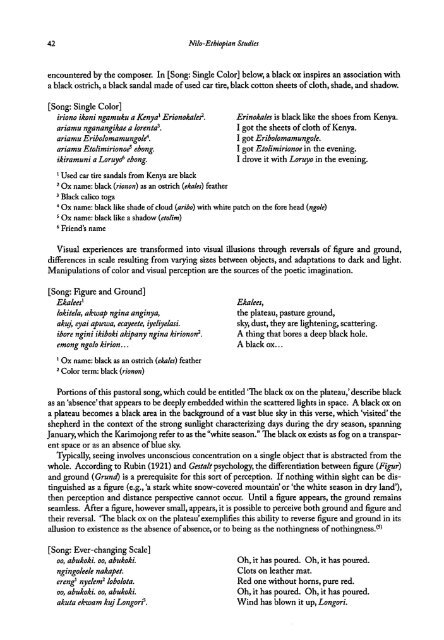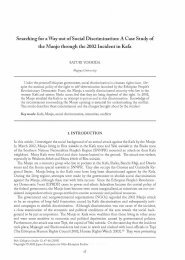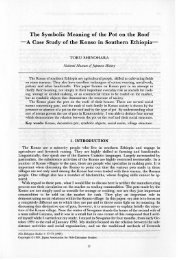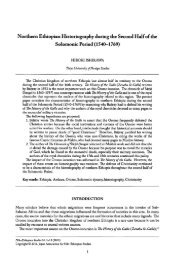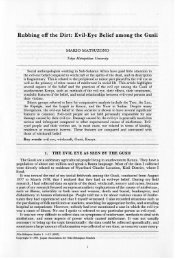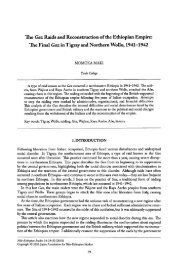Daily Life as Poetry: The Meaning of the Pastoral Songs of the ...
Daily Life as Poetry: The Meaning of the Pastoral Songs of the ...
Daily Life as Poetry: The Meaning of the Pastoral Songs of the ...
You also want an ePaper? Increase the reach of your titles
YUMPU automatically turns print PDFs into web optimized ePapers that Google loves.
42 Nilo-Ethiopian Studies<br />
encountered by <strong>the</strong> composer. In [Song: Single Color] below, a black ox inspires an <strong>as</strong>sociation with<br />
a black ostrich, a black sandal made <strong>of</strong> used car tire, black cotton sheets <strong>of</strong> cloth, shade, and shadow.<br />
[Song: Single Color]<br />
iriono ikoni ngamuku a Kenya 1 Erionokalei-.<br />
ariamu nganangikae a lorental.<br />
ariamu Eribolomamungole 4 •<br />
ariamu EtolimirionoeS ebong.<br />
ikiramuni a Loruyo 6 ebong.<br />
Erinokales is black like <strong>the</strong> shoes from Kenya.<br />
I got <strong>the</strong> sheets <strong>of</strong> cloth <strong>of</strong> Kenya.<br />
I got Eribolomamungole.<br />
I got Etolimirionoe in <strong>the</strong> evening.<br />
I drove it with Loruyo in <strong>the</strong> evening.<br />
1<br />
Used car tire sandals from Kenya are black<br />
2<br />
Ox name: black (rionon) <strong>as</strong> an ostrich (ekales) fea<strong>the</strong>r<br />
3<br />
Black calico toga<br />
4<br />
Ox name: black like shade <strong>of</strong> cloud (aribo) with white patch on <strong>the</strong> fore head (ngole)<br />
5<br />
Ox name: black like a shadow (etolim)<br />
6<br />
Friend's name<br />
Visual experiences are transformed into visual illusions through reversals <strong>of</strong> figure and ground,<br />
differences in scale resulting from varying sizes between objects, and adaptations to dark and light.<br />
Manipulations <strong>of</strong> color and visual perception are <strong>the</strong> sources <strong>of</strong> <strong>the</strong> poetic imagination.<br />
[Song: Figure and Ground]<br />
Ekalees 1<br />
lokitela, akwap ngina anginya,<br />
akuj, eyai apuwa, ecayeete, iyeliyel<strong>as</strong>i.<br />
ibore ngini ikiboki akipany ngina kirionon 2 •<br />
emong ngolo kirion ...<br />
Ekalees,<br />
<strong>the</strong> plateau, p<strong>as</strong>ture ground,<br />
sky, dust, <strong>the</strong>y are lightening, scattering.<br />
A thing that bores a deep black hole.<br />
A black ox ...<br />
1<br />
Ox name: black <strong>as</strong> an ostrich (ekales) fea<strong>the</strong>r<br />
2<br />
Color term: black (rionon)<br />
Portions <strong>of</strong> this p<strong>as</strong>toral song, which could be entitled '<strong>The</strong> black ox on <strong>the</strong> plateau,' describe black<br />
<strong>as</strong> an 'absence' that appears to be deeply embedded within <strong>the</strong> scattered lights in space. A black ox on<br />
a plateau becomes a black area in <strong>the</strong> background <strong>of</strong> a v<strong>as</strong>t blue sky in this verse, which 'visited' <strong>the</strong><br />
shepherd in <strong>the</strong> context <strong>of</strong> <strong>the</strong> strong sunlight characterizing days during <strong>the</strong> dry se<strong>as</strong>on, spanning<br />
January, which <strong>the</strong> Karimojong refer to <strong>as</strong> <strong>the</strong> "white se<strong>as</strong>on." <strong>The</strong> black ox exists <strong>as</strong> fog on a transparent<br />
space or <strong>as</strong> an absence <strong>of</strong> blue sky.<br />
Typically, seeing involves unconscious concentration on a single object that is abstracted from <strong>the</strong><br />
whole. According to Rubin (1921) and Gestalt psychology, <strong>the</strong> differentiation between figure (Figur)<br />
and ground (Grund) is a prerequisite for this sort <strong>of</strong> perception. If nothing within sight can be distinguished<br />
<strong>as</strong> a figure (e.g., 'a stark white snow-covered mountain' or '<strong>the</strong> white se<strong>as</strong>on in dry land'),<br />
<strong>the</strong>n perception and distance perspective cannot occur. Until a figure appears, <strong>the</strong> ground remains<br />
seamless. Mter a figure, however small, appears, it is possible to perceive both ground and figure and<br />
<strong>the</strong>ir reversal. '<strong>The</strong> black ox on <strong>the</strong> plateau' exemplifies this ability to reverse figure and ground in its<br />
allusion to existence <strong>as</strong> <strong>the</strong> absence <strong>of</strong> absence, or to being <strong>as</strong> <strong>the</strong> nothingness <strong>of</strong> nothingness. <br />
[Song: Ever-changing Scale]<br />
oo, abukoki. oo, abukoki.<br />
ngingoleele nakapet.<br />
erengl nyelem 2 lobolota.<br />
oo, abukoki. oo, abukoki.<br />
akuta ekwam kuj Longorr.<br />
Oh, it h<strong>as</strong> poured. Oh, it h<strong>as</strong> poured.<br />
Clots on lea<strong>the</strong>r mat.<br />
Red one without horns, pure red.<br />
Oh, it h<strong>as</strong> poured. Oh, it h<strong>as</strong> poured.<br />
Wind h<strong>as</strong> blown it up, Longori.


